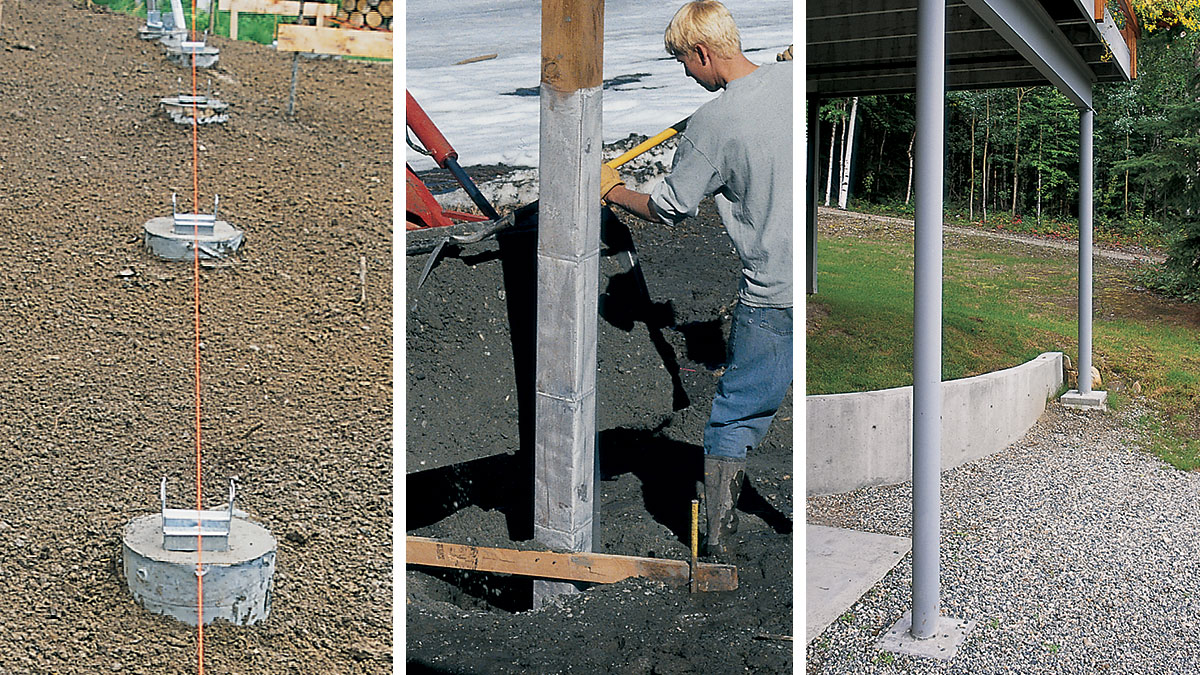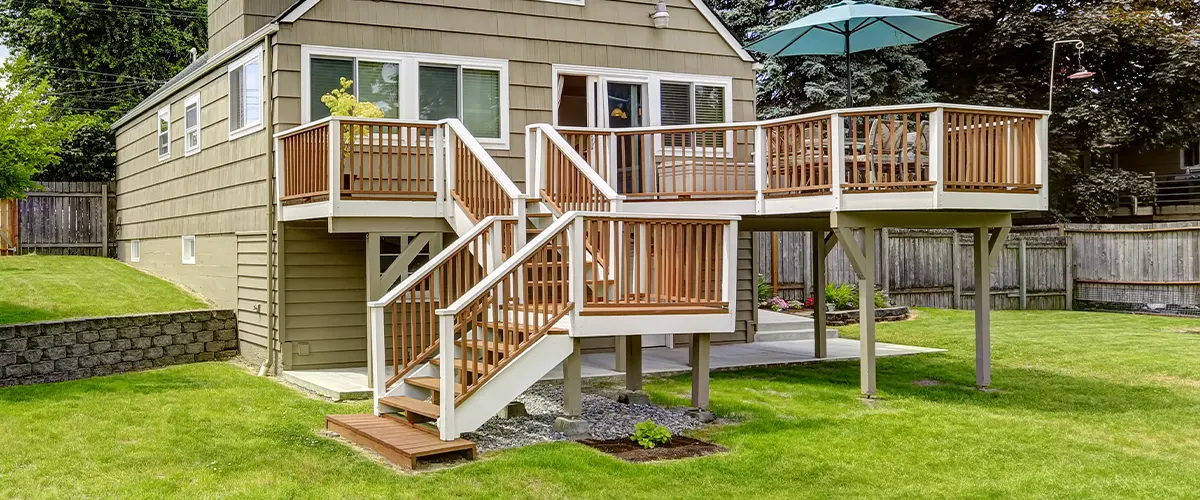From Idea to Concrete: The Vital Duty of Deck Footings in Sturdy and Safe Decks
From Idea to Concrete: The Vital Duty of Deck Footings in Sturdy and Safe Decks
Blog Article
Selecting the Right Deck Footings for Stability and Durability
When it comes to constructing a deck, among the most critical choices you will make is choosing the best footings for security and sturdiness. The longevity and safety and security of your deck depend heavily on the kind of footings you pick, as they supply the important assistance and stability to withstand the examination of time. With a myriad of options offered, it can be overwhelming to figure out which footings are best matched for your particular demands. In this discussion, we will certainly explore the different types of deck grounds, consider the crucial factors to evaluate when choosing, and explore the pros and cons of different alternatives. By the end, you will have a clearer understanding of the selections available and be far better equipped to make a notified choice for your deck project.
Sorts Of Deck Grounds
These footings consist of a cylindrical hole filled with concrete, which provides a strong structure for the deck blog posts. Concrete pier grounds are reasonably very easy to set up and use exceptional security, making them a prominent option for numerous deck projects.
These grounds are set up by screwing them into the ground, which develops a safe foundation for the deck. They additionally permit for simple change and progressing of the deck if needed.
Conversely, some building contractors choose precast concrete footings. These grounds are made of sturdy concrete and be available in various sizes and shapes to suit different deck layouts. Precast concrete footings are hassle-free to set up and provide a steady base for the deck structure.
Lastly, another alternative is the post-in-anchor footing system. This kind of footing includes driving a metal anchor right into the ground and connecting it to the deck message. It uses adaptability in terms of positioning the deck articles and is appropriate for decks with light-weight frameworks.
When selecting the ideal sort of deck ground, it is necessary to think about aspects such as soil problems, deck load, and regional building regulations (Deck Footings). Consulting with a professional service provider or structural engineer can assist make certain the suitable ground is picked for a secure and safe deck
Aspects to Take Into Consideration When Choosing Footings
When choosing the ideal footings for a deck, it is important to carefully consider different aspects such as dirt problems, deck load, and adherence to local building regulations. These aspects play a substantial duty in ensuring the stability and sturdiness of the deck framework.
The kind of soil on which the deck will be built establishes the kind of footings required. On the various other hand, decks constructed on clay or extensive soils might call for footings that can accommodate the dirt's propensity to expand and agreement.
An additional crucial element is the deck load. The weight of the deck, consisting of the materials used and any kind of prospective live lots such as furniture or gatherings, should be considered when picking footings. The footings need to be developed to bear the weight of the deck and disperse it evenly to avoid any type of structural concerns or failures.
Last but not least, adherence to regional building ordinance is vital. Building ordinance differ from region to area, and it is vital to adhere to the certain requirements established by the local authorities. Deck Footings. These codes make certain that the deck is built securely and meets the needed standards for architectural integrity and load-bearing capability
Concrete Grounds: Disadvantages and pros

Concrete footings use a number of benefits and downsides when made use of as the structure for a deck. On the favorable side, concrete grounds supply superb security and longevity.
An additional benefit of concrete grounds is their adaptability. They can be put into different shapes and sizes to suit numerous deck styles and setups. Concrete footings can be customized to fit the specific needs and demands of the deck structure.
However, there are likewise some drawbacks to utilizing concrete footings. One significant negative aspect is the price and labor associated with their setup. Concrete footings require excavation and often require the aid of hefty machinery. This can increase the total expense of the deck project and might call for expert assistance.

Helical Piers Vs. Sonotubes: Which Is Much better?
In thinking about the foundation options for a deck, the comparison in between helical piers and sonotubes is critical in establishing the premium option. They are twisted into the ground making use of hydraulic equipment, offering a stable and durable foundation for the deck.
When it concerns security and longevity, helical piers have the top hand. The helical plates on the piers create a click to read solid grip with the dirt, stopping any type of movement or changing of the deck. This is specifically helpful in areas with unpredictable or moving soil problems. Sonotubes, on the other hand, count entirely on the concrete loading for stability, which might not use the same degree of strength and resistance.
In regards to installation, helical piers are fairly less complicated and faster to set up contrasted to sonotubes. The hydraulic equipment used to turn the piers right into the ground guarantees a effective and fast procedure. Sonotubes, on the other hand, need excavating openings and pouring concrete, which can be lengthy and labor-intensive.
Additionally, helical piers are a more flexible alternative. They can be used in different dirt problems and can be readjusted or strengthened if required. Sonotubes, on the other hand, may need extra assistance, such as rebar, in particular dirt conditions or areas with high load demands.
Choosing the Right Footings for Your Deck's Measurements
For optimum architectural integrity, it is vital to meticulously select the appropriate footings that align with the dimensions of your deck. The dimensions of your deck, including its width, length, and height, play a considerable function in figuring out the type and size of footings required.
When selecting footings for your deck, it is necessary to consider the load-bearing capacity of the dirt. The weight of the deck, incorporated with the weight of any kind of furnishings or people on it, exerts a significant force on the grounds (Deck Footings). It is crucial to pick grounds that can sufficiently support this weight without sinking or shifting over time.
The shapes and size of the grounds must likewise be considered. Bigger decks with higher dimensions call for bigger footings to give adequate stability and assistance. The shape of the grounds, whether they are rounded or square, relies on the style and layout of the deck. In addition, the depth at which the grounds are set up should be established based on the frost line in your area to stop any heaving or changing because of freezing temperatures.
Final Thought
In verdict, choosing the best deck grounds is critical for making certain stability and sturdiness. Aspects such as the kind of grounds, the deck's measurements, and the pros and cons of different options ought to be thought about.
These footings consist of a cylindrical hole filled up with concrete, which supplies a strong structure for the deck articles. Concrete pier grounds are reasonably very easy to mount and supply superb security, making them a preferred selection for several deck tasks.
Precast concrete grounds are hassle-free to mount and supply a steady base for the deck structure.
It provides versatility in terms of positioning the deck posts and is suitable for decks with look at this website light-weight frameworks.
Concrete grounds use a number of advantages and disadvantages when used as the structure for a deck.
Report this page